
12 月 . 03, 2024 16:27 Back to list
Exploring the Molarity of Glacial Acetic Acid in Various Solutions
Understanding the Molarity of Glacial Acetic Acid
Acetic acid, with the chemical formula CH₃COOH, is a colorless liquid organic compound that has a distinctive pungent smell. When in its pure form, it is known as glacial acetic acid. The term glacial refers to its ability to solidify at lower temperatures, forming ice-like crystals. Glacial acetic acid is a key industrial chemical and is widely used in the production of a variety of chemicals, including vinegar, synthetic fibers, and plastics. Understanding its molarity is crucial for various applications in chemistry and industry.
What is Molarity?
Molarity is a measure of concentration that expresses the number of moles of solute per liter of solution. It is a critical concept in chemistry because it allows chemists to quantify the concentration of solutions, making it easier to perform calculations involving reactions, dilutions, and other properties. Molarity is denoted by the symbol ‘M’ and is expressed as
\[ \text{Molarity (M)} = \frac{\text{moles of solute}}{\text{liters of solution}} \]
For glacial acetic acid, calculating molarity involves determining the amount of acetic acid present in a specified volume of solution.
Density and Molarity of Glacial Acetic Acid
The density of glacial acetic acid is approximately 1.05 g/mL at room temperature. This means that one milliliter of glacial acetic acid weighs about 1.05 grams. To calculate the molarity, we first need to determine how many grams of acetic acid are contained in a given volume of glacial acetic acid and then convert that mass to moles.
The molecular weight of acetic acid is about 60.05 g/mol. Therefore, to convert grams to moles, the following formula is used
\[ \text{Moles} = \frac{\text{mass (g)}}{\text{molecular weight (g/mol)}} \]
For example, if we take 100 mL of glacial acetic acid
molarity of glacial acetic acid

1. Calculate the mass \[ 100 \text{ mL} \times 1.05 \frac{\text{g}}{\text{mL}} = 105 \text{ g} \] 2. Convert mass to moles \[ \text{Moles} = \frac{105 \text{ g}}{60.05 \text{ g/mol}} \approx 1.75 \text{ moles} \]
3. Since we are considering 0.1 L of solution (100 mL), the molarity can now be calculated \[ \text{Molarity (M)} = \frac{1.75 \text{ moles}}{0.1 \text{ L}} = 17.5 \text{ M} \]
Thus, the molarity of glacial acetic acid is approximately 17.5 M, indicating a very concentrated solution.
Applications and Importance
Understanding the molarity of glacial acetic acid is essential for a variety of applications. In laboratory settings, precise molarity is critical for titrations and reaction calculations. In industrial settings, it is used in the synthesis of various chemicals, including acetic anhydride and acetate esters, which are important in pharmaceuticals and plastics.
Moreover, glacial acetic acid is often diluted for use in food products, notably vinegar, which typically contains around 4-8% acetic acid by volume. Knowledge of molarity assists food manufacturers in ensuring product quality and safety.
Safety and Handling
Despite its widespread use, glacial acetic acid is a corrosive substance and should be handled with care. Direct contact can cause irritation to the skin, eyes, and respiratory tract. Proper safety precautions, such as wearing gloves and goggles, are essential when working with this chemical.
Conclusion
Glacial acetic acid is a valuable chemical that plays a significant role in both laboratory and industrial applications. By understanding its molarity, chemists can ensure accurate measurements, facilitate safe handling, and optimize its use in various chemical processes.
